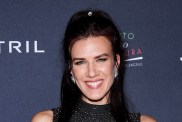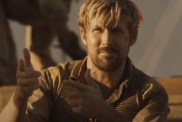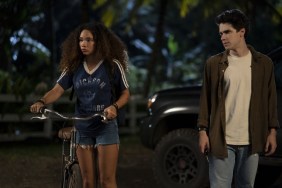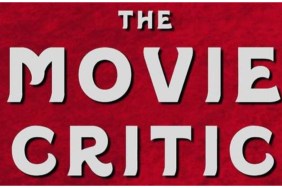Filmmaker Steven Quale is an interesting guy, something Comingsoon.net first learned when we met him on the set of Final Destination 5 a few years back. At the time, he was coming off a long run working with James Cameron, doing second unit directing on a couple of little movies called Avatar and Titanic and directing the IMAX doc Aliens of the Deep, and he showed an enormous amount of confidence as the director of his first dramatic feature film.
Final Destination 5 certainly turned a lot of heads, especially among fans of that franchise (such as myself), and now Quale is back with Into the Storm, a far more reality-based look at the enormous tornadoes that have been plaguing the Heartland of our country for the past few years.
It takes place in a fictional town in the Midwest that’s about to become the center of a number of twisters that are expected to converge into an enormous super-twister. We see the results of that devastation through the eyes of a group of stormchasers, including Sarah Wayne Callies (“The Walking Dead”), Matt Walsh, Jeremy Sumpter and Arlen Escarpeta, as well as a father (Richard Armitage from “The Hobbit”) and his two sons.
ComingSoon.net sat down with Quale earlier this week for an extended chat about the making of his latest movie.
CS: You directed “Final Destination 5” and before that you directed a few docs and some shorts, so what led you to directing more of a real world disaster flick?
Steven Quale: Well, what happened is Todd Garner came up with the idea and John Swetnam wrote the script and they brought it to New Line and New Line immediately said, “We have the perfect director for this,” so they gave me the script. I read it. I was very intrigued because I grew up in the Midwest and experienced severe storms and tornado warnings. I never actually witnessed a tornado myself in person, but I knew exactly what they were like and what potential devastating power that they have. I liked the script – I thought that it was a very engaging story that was told through a lot of peoples’ points of view as they’re all witnessing this event. What I thought I could bring to the table was a sense of realism because we have a lot of summer movies–and having done a horror movie that involves an excessive over-the-top type of event–I thought, well, if we can show the incredible power of Mother Nature. It’s almost an awe and a respect that you have for the forces that we feel so insignificant as humans on the scale of what these systems could do, that it’d be great to tell the human story about these people trying to react, fight, and survive, to run away from this disaster, and what happens to a community when you sort of group together in adverse situations like that. You rise to the occasion, you help one another. Some of the things that you think were petty when you first started, you realize what’s really important is family and the loved ones, even if it’s external family, per se.
CS: It’s a very timely subject matter now in terms of it’s always in the news, all the devastation of tornadoes, maybe more now than 20 years ago. Approaching a movie like this where you’re dealing with something that might be sensitive to areas where they’re in danger of twisters all the time, how do you deal with that?
Quale: My feeling on that is we embrace the human condition and how it rises up to adverse situations like this as opposed to glorifying the destruction. It’s a personal story told by the people who are engaged in trying to just survive. I think that the first person narrative I used to tell the story with the handheld cameras and so forth gives it a certain immediacy and realism to it that you wouldn’t get in a glossy Hollywood movie. I think that helps engage in dealing with it. When you mentioned something about global climate change, and we touched upon it a little bit in the film, but I wanted to be careful because first and foremost, this is an entertaining ride. What scares people often intrigues them. You want to see what it’s like to be right there in the middle of a tornado?
CS: Quite literally in some cases?
Quale: Yeah, and feel what it’s like. People are always seeking that, whether intentional or unintentional, so this film delivers on that, but it delivers in the safety of being in a movie theater, where you can hang onto your loved one while you’re watching it and not be in harm’s way in reality. It deals with the issues of what you do when you come up against something like that? Do you run away? Do you help the person next to you? What kind of person and what is your character based on this unpredictable natural phenomenon? It’s not like it’s a villain that’s seeking you out, it just is a random thing and you have to react to it.

CS: Many filmmakers hate the term “found footage,” which is being used more and more in the realm of genre, although this is really more about creating a documentary-type format using the camerawork? It’s really using more documentary type footage with the camera and stuff like that. Was that something you wanted to do with this from the very beginning?
Quale: Absolutely. I was intrigued by it because A.) for better or worse, the found footage genre is with us and it’s going to be with us for a while and it’s only going to expand. I felt that I could do a hybrid, so I don’t really call this a found footage movie. I use maybe it’s a very egotistical, naïve thing, but I call it “the first person narrative.” What that means is, it’s told through the camera’s point of view, but it’s not necessarily the really shaky camera and bad camerawork that a found footage movies sometimes has. Because we’re dealing with professional storm chasers who are camera operators, documentary filmmakers, so they’re taking more of that approach and having the experience of being a documentary filmmaker, I blended that with the narrative storytelling. At a certain point, I feel that the found footage gimmick gets in the way of telling a story because you obsess so much on the camera and the techniques of how you’re getting that footage and the justification of it versus just telling a good story.
CS: You’ve been very much at the forefront of 3D from your work with James Cameron, so was there ever any talk of trying to do a 3D tornado movie?
Quale: Well, I love 3D, and I think 3D should be decided by the filmmaker, not the studio. For this case, since we were dealing with so many cameras and different types of media that people were recording on. Nobody has 3D cameras, so I felt it would be false if we were going to make this movie in 3D. If I had decided to make a traditional movie that had normal shots and cinematic style, then 3D would be perfect for this. But because we were dealing with the first person narrative, I was very insistent that we should make this as a 2D film, and fortunately, the studio supported me with that, which is fantastic.
CS: The casting is somewhat unconventional–first of all, you brought Arlen back from “Final Destination” and I’m a big fan of his–but it’s different in that you have Matt Walsh in a more serious role, Richard Armitage is this British stage actor playing an American teacher and father?
Quale: All good actors are good actors and can do pretty much everything they set their mind to. People get typecast in certain roles or traits. The thing about it is that all these actors are great and I always love to give an actor something that they aren’t known for or a different take on something new because they find that exhilarating and interesting and Matt Walsh, being a comedy guy, really loved the challenge to try to do something dramatic, and also bring some of his dry ironic humor into his character and his attitude, kind of like the guy who’s been there for 10 or 15 years trying to do this and hasn’t succeeded and is kind of jaded in his sensibilities. Matt did a great job there, plus he’s a lot of fun to be with on the set. Somebody like Richard Armitage, who is known as this large warrior, actually a small person, but a warrior in “The Hobbit,” and totally in control and commanding his army to be this sort of bureaucratic assistant principal having to listen to the higher-ups telling him what to do and trying to deal with his kids who are in that rebellious teenage time, it felt great to really humanize him and make him just an ordinary person who has all these tiny little problems that everybody has dealing with your kid, dealing with work, and then, suddenly getting thrust in this huge disaster and having to decide, “Well, what am I going to do?” It’s almost on instinct and it’s his quiet inner strength that allows him to persevere and sort of take charge and reluctantly lead these people to safety. That was a great mix to be able to play that. Of course, Sarah Wayne Callies just immediately from her previous work, I was a big fan and I just loved bringing the authenticity and the intelligence of her role as a female meteorologist and expert in that field, and being a mother and trying to deal with that anxiety of being separated from your daughter because you’re trying to do something that’s probably for the good of the greater society by learning more about these storms. But yet, you’re doing the self-sacrifice of not being with your kid. Every parent knows what it’s like to be away from your children, particularly in a time of stress, like a major storm. In Richard Armitage’s case, it’s like having the son being missing and being trapped in a building that was collapsed by a tornado was even more tension and grief that they have. So the two single parents that kinda get thrust amongst each other in the chaos of this film, I think was just a nice way to be the eyes for the audience to see all the spectacle, because without that, it would just be spectacle and you wouldn’t care and there’d be a lot of big tornados and a lot of disasters, and then the movie is over.
CS: I really liked Sarah in that role. A lot of time you see these movies and they hire an actress with a pretty face who just isn’t convincing at all playing a scientist.
Quale: I completely agree with you, and thank you, because I looked really closely on it. That’s one of my pet peeves is you can’t have the beautiful face trying to say words that they don’t understand. The beauty about Sarah is she really learned what every single technical word meant. She said, “I can’t say it if I don’t know what it really is about,” and went into the research and questioned everything and it was a great collaboration with her to make her dialogue and her character feel as real as possible. It’s a joy when you get that sort of relationship because with the printed page, on the script is just words, and then the actors breathe life into that, and suddenly they’re their own characters and they form and evolve and take shape as you’re filming the movie.

CS: How did you deal with the actors in terms of the stuff that would be added via CG? I can tell you did some practical stuff, but it seems like there would be a lot that would be added later.
Quale: Well, that’s sort of an in joke, but basically the first day of shooting was the scene by the barn where they stop outside and they’re all looking at the tornado forming for the very first time. Our first take, Arlen points, Sarah points, Matt Walsh starts pointing, and now we have four actors all pointing into the sky and there’s nothing wrong with pointing, but these guys have seen a lot of tornados all the time, so it was just one of those things that you can get the same thing without actually pointing. It was just kind of a funny thing. Ever since that first day when we said, “No pointing,” and then everybody got it and we were on the same page. But it’s a testament to their acting skills, to be able to imagine what that was. I mean, it helped that we had fans and wind scenes and practical effects around them so they could kind of immerse themselves. But the actual visuals, I showed them a lot of YouTube video of real tornados so they could see what they look like, so that when we’re doing a scene, they could imagine that. But it’s a Michigan sunny summer blue sky in the background and we’re trying to make it feel like it’s this dark, gloomy tornado.
CS: Earlier, you mentioned growing up in the Midwest where there were a lot of tornado warnings, and I spent much of last year in Columbus, Ohio where inclement weather would lead to a weathercaster being on TV for four hours straight talking about tornadoes that may or may not be forming. It was literally his moment to be on TV for four hours.
Quale: Right. Well, one of the things in our film, we have a few shots with the TV of weathercasters talking about the severe weather. We were very fortunate to get real Michigan-based weather and sportscasters that played the role as the TV people, so that it felt real. They had the experience of what a reporter or an anchor person has, so that was a lot of fun, injecting some of the local people. Technically, people seeing this movie can say, “Well, wait a minute. If this is supposed to take place in this fictitious town, why do we have Detroit personalities doing the weather?” But, they did a great job and it was a lot of fun to work with them.
CS: While I can usually tell what was built and what was a location, but there is a lot of outdoor locations.
Quale: Actually, it was one of the rarer films where we built very little sets. We had one sequence where the school hallway rips off, so that was a built set. Then, we had some interiors, but almost all of the film was done in practical locations and we just went through Michigan and found all these great locations and used the best that we could.
CS: Did you build the storm drain?
Quale: The storm drain at the very end was a set as well. Besides that, but as far as the practical school itself, we were in a real school in Michigan. It’s kind of funny, because we rented it during the summer, when classes weren’t in, and we had to destroy it to make it look like there was a tornado. The guy who was in charge of making sure it was okay didn’t know to what extent we’d be doing these prop bricks and artificial things. He came in freaking out. We put plywood and were really safe to cover everything so we didn’t permanently damage it, but it had this illusion of getting ripped through with a tornado and it was very effective when the senior guy in charge of that was freaking out that we damaged his school.
CS: It’s funny seeing the parking lot after the tornado, which is just amazing because you have all these overturned cars and garbage, but you were also shooting real buildings that would then be destroyed by tornadoes, so did you scan those locations into the computer?
Quale: Well, one of the things we thought of is we had a housing development that we needed a tornado to go through and destroy a couple houses. We figured, “Well, how do you do that?” So, we came up with the idea of going to a brand new housing community that they’re building houses that are under construction. So those houses under construction, we put set dressing to make it look like it was a post-tornado destruction. That way, we could have full-sized houses right next door that are intact. Tornados are very selective, they just randomly go and one house gets completely destroyed and the other one is completely intact, so that allowed us to get a neighborhood to make it feel real with not having to build every house up completely from scratch.
CS: It’s one of those things you always wonder about when you see a movie using a documentary style of filmmaking but it then has CG FX that are more customary in a cinematic film, and you often wonder how they make it seem so real.
Quale: Right, and just the way you do it, you have a handheld camera and have these digital background buildings and the foreground is practical, but you’re not focusing on the background, it’s almost a throwaway. It feels even more real than trying to say, “Well, here’s our grand shot of destruction, let’s glorify it and show it as opposed to telling the story following with the actors, and in the background, you see all this as they’re interacting.” I think that approach is often much more effective.

CS: I wanted to ask about designing and building the Titus (the main storm chaser vehicle), because it has such a unique look to it.
Quale: Well, the Titus was the ultimate storm chasing vehicle. It has to withstand the wind forces of a tornado, so it was a lot of fun to build and design. David Sandefur, the production designer, had a team that created a wonderful concept art, and finally got the final design down. Then a team called Custom Kreations in Detroit built the actual vehicle based on a pickup chassis. They have built a lot of prototype and concept cars for the big three Detroit auto manufacturers, so it was great to have somebody familiar with real vehicles building our prop vehicle and getting all the details right with the actual hydraulic actuators that would extend and fire spikes into the ground to sort of hold this vehicle, and prevent it from the intense winds it would (have to withstand). The vehicle looked great, but of course, like any prop, we did not build it to actually survive a tornado. It looks like it can, so it’s just built enough to look good for filming. So as a result of that, unfortunately, the first day of shooting when we put all of our rain machines in, the windows leaked, so Matt Walsh is doing a scene and we’re all filming, and all of a sudden, he starts going off script. He said, “Boys, we’ve got a breach here. Don’t worry. Keep going.” Water started gushing in, completely drenching his wardrobe and everything. Then, we realized they hadn’t caulked the windows, and little minor details like that. But we got all that sorted out as you’re making the movie, those things happen.
CS: I was also amused as I was watching it by the number of flying cars and trucks. Did you actually have some sort of car catapult to do that on set?
Quale: What we actually did is we had the pickup truck that falls down right before Richard Armitage is running in the main street scene. That was all practical and real and we had a complex mechanism, where they take a cable and wind up the truck and then let it go. It’s almost like a yo-yo, and then the truck rotates as it’s falling down in a controlled manner. That was a practical stunt that we basically told Richard, “You run forward and stop. If you go any further, you will die.” Then, everything was really safe and we had safety cables on and everything, so he couldn’t possibly go any further, but it was all done in camera and practical with a long lens to accentuate that this wasn’t quite as close as it looks in the film because of trickery like that. But it gave that sense of realism so that the digital trucks before and after, felt in place because you had something grounded in reality to judge the other shots by.
CS: It’s great how you create illusions like that, and I felt you did that in “Final Destination 5,” too. You watch it and you’re not sure what was done on set or added later. Did you have any idea that your movie was going to be coming out so soon after the “Sharknado” sequel? (Speaking of scenes with everyone pointing at the sky.)
Quale: Well, so we made the movie before “Sharknado” even existed. “Sharknado” was a phenomenon that occurred after we made our movie, so it’s just one of those amusing social phenomena things that happened and had nothing to do with it.
CS: Do you think people will understand it’s not that movie?
Quale: I think people understand it. I think “Sharknado” is a title, and you have that title and it says everything. It’s just a campy thing that people can have fun with and it’s just a phenomenon, and sometimes, those things work, and sometimes they don’t. There are other films that try to do a similar thing that completely tanked under that high concept cheesy, horrible looking type movie. Sometimes, people react to it, and sometimes they don’t, so it’s just a kind of a hit or miss thing, I’m not too familiar with that genre myself because I hopefully try not to make my movies bad intentionally.
CS: Of course, you worked with James Cameron who famously directed “Piranha 2”?
Quale: Well, as he has said, “the best flying fish movie ever made.”
CS: Do you know what you want to do next? I mean, obviously you’ve done two very effects heavy movies in a row, although this one is slightly less genre-ish.
Quale: It’s interesting because today’s world, there’s not a lot of drama movies that are being made anymore because it’s all about effects-driven superhero tentpole type of action projects. So people who have that unique skill set to do, if they can get some kind of a compelling story amongst that, that’s fantastic, but most of the dramas now are either going to HBO or television or a few select movies that the independent studios make, but it’s not nearly what it was in the past, which is kind of sad. It’s liberating that television’s taking up the slot there and giving us some great programs and miniseries and other things, so I am open to anything. There’s several projects that are really intriguing for me that I’m working on, but no specific one as of now.
CS: Are you interested in doing some television?
Quale: I have been approached, actually, but unfortunately, my schedule didn’t allow to do some television. I would love to do it, but I just couldn’t fit it in.
Into the Storm opens on Friday, August 8 in regular and IMAX theaters with previews on Thursday night. You can also watch ideo interviews with Quale’s cast by clicking here









